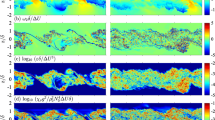Abstract
We have developed a new method to accelerate tracer simulations to steady-state in a 3-D global ocean model, run off-line. Using this technique, our simulations for natural 14C ran 17 times faster when compared to those made with the standard non-accelerated approach. For maximum acceleration we wish to initialize the model with tracer fields that are as close as possible to the final equilibrium solution. Our initial tracer fields were derived by judiciously constructing a much faster, lower-resolution (degraded), off-line model from advective and turbulent fields predicted from the parent on-line model, an ocean general circulation model (OGCM). No on-line version of the degraded model exists; it is based entirely on results from the parent OGCM. Degradation was made horizontally over sets of four adjacent grid-cell squares for each vertical layer of the parent model. However, final resolution did not suffer because as a second step, after allowing the degraded model to reach equilibrium, we used its tracer output to re-initialize the parent model (at the original resolution). After re-initialization, the parent model must then be integrated only to a few hundred years before reaching equilibrium. To validate our degradation-integration technique (DEGINT), we compared 14C results from runs with and without this approach. Differences are less than 10‰ throughout 98.5% of the ocean volume. Predicted natural 14C appears reasonable over most of the ocean. In the Atlantic, modeled Δ14C indicates that as observed, the North Atlantic Deep Water (NADW) fills the deep North Atlantic, and Antartic Intermediate Water (AAIW) infiltrates northward; conversely, simulated Antarctic Bottom Water (AABW) does not penetrate northward beyond the equator as it should. In the Pacific, in surface eastern equatorial waters, the model produces a north–south assymetry similar to that observed; other global ocean models do not, because their resolution is inadequate to resolve equatorial dynamics properly, particularly the intense equatorial undercurrent. The model’s oldest water in the deep Pacific (at −239‰) is close to that observed (−248‰), but is too deep. Surface waters in the Southern Ocean are too rich in natural 14C due to inadequacies in the OGCM’s thermohaline forcing.
Similar content being viewed by others
Author information
Authors and Affiliations
Additional information
Received: 18 March 1997 / Accepted: 27 July 1997
Rights and permissions
About this article
Cite this article
Aumont, O., Orr, J., Jamous, D. et al. A degradation approach to accelerate simulations to steady-state in a 3-D tracer transport model of the global ocean. Climate Dynamics 14, 101–116 (1998). https://doi.org/10.1007/s003820050212
Issue Date:
DOI: https://doi.org/10.1007/s003820050212




